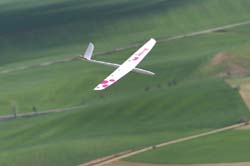
Pierre Rondel
04/12/2006
|
Pierre Rondel |
Flying DS since 2000 I always been afraid to use and maybe one day explode one of my F3F sailplanes that cost a fortune. that's why I was looking for a dedicated DS plane to fly even more faster without the stress.
When Miguel Medina showed the early master of the Vector DS 2 meters in 2005, I rapidly ordered one, but have to wait until La Muela 2006 to get it (second exemplar moulded).
Why 2 meters ? Well, it seems that the ideal size to fly hard DS is around 2 meters. The reason is that it's much more easyer to mould a rock solid 2m plane than a 3 meters sailplane, even if I consider that a bigger plane is probably more stable and easyer to pilot.

Anyway, today on the market, all the successful DS planes are around 2 meters like the Opus MC3 or the world record holder Exxtreme manufactured in US by Brian McLean.
The vector DS differentiates from the competition by a 2 pieces wing and 2 pieces tailplane which is very convenient for transportation. Let's have a look on the different components on the kit.
The fuselage is made of fiberglass with carbon reinforcement, especially on the tail boom. Tailplane joiners are in place and all the "anti rotation pin" holes are done. Pushrods are in place. This fuselage can receive plenty of ballast in a tube similar to the elita or Ellipse 4. The finish is clean but not perfect.
The wings are made of a HT carbon cloth over a high density foam core (polystyren). The spar is "over dimmensioned" and made of carbon sock around a extruded foam core. There is also a secondary spar to close the wing along the ailerons and flaps. ailerons and flaps are articulated thanks to a silicon hinge.
The tailplanes are made of a fiberglass/herex/fiberglass sandwitch with a carbonfiber spar and enbeded integral hinge. Both tailplanes and wings receive aluminium anti rotation pins.
The radio installation is pretty standard. I used the following components:

All the control horn on the wing are in alloy metal 4mm, and the linkages use M3 clevisses.
I faced a couple of small issues during the assembly:
To finish, I install a removable antenna made of a piano wire to make sure that the reception is good in all situations. My CG is at 95 mm from the leading edge (recommended CG is between 93 and 96 mm). The weight is 1.9 Kg wich is heavy for a only 2m wingspan sailplane, but the positive point is that the Vector DS is rock solid !
I flew the Vector on the front side plenty of time: this is a very nice sport flying glider capable of F3F (I did the best time during a competition last summer), basic aerobatics, but its preferred flight domain is obviously Dynamic Soaring. And I can tell you, the Vector DS rocks !!!!
But, instead of writing a long section about DS, I let you to watch the 2 following videos:
 |
DS at Brié (Grenoble / France) .wmv file / size: 5 Mo |
 |
DS at "le Col des Faisses" (Corps / France) .wmv file / size: 5 Mo |
In conclusion, if you look for a dedicated DS sailplane, the Vector DS is a plane to consider.
For any information related to prices and delivery time, please contact the manufacturer: aero @ mmedinat.jazztel.es (suppress the spaces around the @ before to use the email address)


 |
 |
 |
 |
 |
 |
 |
 |
 |
 |
 |
 |
 |
 |
 |
 |
 |
 |
 |
 |
 |
 |
 |
 |
 |
 |
 |
 |
 |
 |
 |
 |
 |
 |
 |
 |
 |
 |
 |
 |
 |
 |
 |
 |
 |

Copyright
© 1998-2006 Planet-Soaring.com
No commercial use or publication (e.g. on
other www or ftp sites, print media) without a written consent.